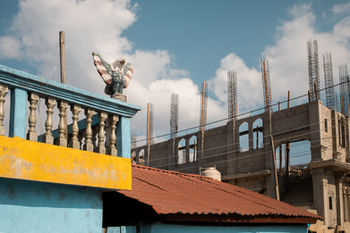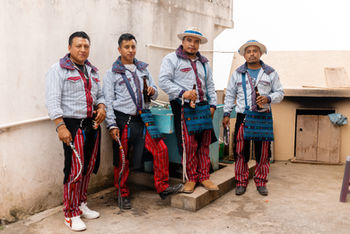Tu pueblo sabe

En el corazón de las montañas de los Cuchumatanes, en los altiplanos occidentales de Guatemala, se encuentra Todos Santos Cuchumatán, un territorio que, según datos del Instituto Nacional de Estadística, está habitado por más de 30,000 personas, de las cuales el 88% son mayas de la etnia Mam, y cuya población actualmente tiene una edad promedio de 25 años y medio.
La comunidad de Todos Santos, al igual que muchas otras en Guatemala, ha enfrentado históricamente un contexto que ha castigado severamente a las poblaciones mayas del país, con profundos niveles de desigualdad, acceso limitado a servicios públicos y significativas brechas en el acceso a fuentes de empleo. Esto ha resultado en una capacidad restringida de resiliencia frente a la pobreza, la violencia y los efectos del cambio climático. La respuesta a esta combinación ha sido una diáspora de personas que abandonan su tierra con la esperanza de encontrar en Estados Unidos las oportunidades que les han sido negadas en su país natal. Cuando alguien nos dice que no tiene un familiar viviendo en el norte, realmente es difícil de creerle, comenta Irineo Gómez, mi guía en Todos Santos, quien prefiere que lo llame Chiri.
Uno de los efectos de la migración es la aparición de familias transnacionales, que, al fragmentarse por el tiempo y el espacio, recurren a diversos métodos para mantener vínculos emocionales, sociales y económicos. Estos se materializan a menudo en intercambios en forma de remesas económicas y culturales, regalos, fotografías, llamadas telefónicas, e incluso, cuando es posible viajar de un país a otro, visitas. Las relaciones se extienden a toda la comunidad, de manera que los migrantes en Oakland, Stockton, Bremerton o Seattle —ciudades que se han convertido en comunidades espejo todosanteras en el norte— financian celebraciones de fiestas patronales, se postulan para alcalde, establecen negocios u organizan recaudaciones para enviar dinero y ayudar a los miembros de la comunidad que enfrentan enfermedades.
Estos intercambios han demostrado tener la capacidad de transformar el paisaje visual de Todos Santos, aunque vale mencionar que este fenómeno también llega a muchas otras regiones de Guatemala. La expresión más común es, sin duda, la arquitectura de remesas. Un término que se refiere a casas y edificios construidos con dinero generado por migrantes, pero cuyo diseño y proceso de construcción son bastante colaborativos, donde las ideas tomadas y comunicadas por el familiar en el extranjero se fusionan con las contribuciones de los miembros de la familia en el país de origen y la interpretación que el constructor local hace de este intercambio de ideas (AECID 2020). Es una arquitectura sin arquitectos, en palabras de Freddi (2020, p. 27), alejada del conocimiento técnico hegemónico aprendido en instituciones académicas de las que las poblaciones indígenas están sistemáticamente excluidas.
En las calles, las 59Fifty con sus viseras planas y logotipos de los A's, Raiders y Mariners se cruzan mientras persiguen autobuses decorados con imágenes de los horizontes urbanos de San Francisco, Miami y Seattle, Washington D.C., mientras manchas de barro imitan la silueta de Jordan en zapatos que acaban de recorrer los caminos bajando de la montaña hacia el centro urbano del pueblo. Restos de migrantes fallecidos regresan para descansar en el cementerio local, en tumbas decoradas con franjas y estrellas. La gente de Todos Santos muestra una gran versatilidad al tomar símbolos e iconografía de Estados Unidos, resignificarlos y utilizarlos en este nuevo contexto como una herramienta narrativa para contar su propia historia de migración, rendir homenaje a la tierra de las oportunidades o conectarse con sus familiares que se aventuraron al norte en busca de una vida mejor.
Los matices de la condición transnacional también se encuentran en la ausencia y pérdida de seres queridos. El buen funcionamiento de los lazos familiares en este espacio depende de la calidad de las redes familiares y de la capacidad de comunicación que existe entre sus miembros.
Esta transformación del imaginario local es el resultado de los esfuerzos de hombres y mujeres que buscan alcanzar la modernidad que no han podido encontrar dentro de sus fronteras. A veces, las montañas de los Cuchumatanes se perciben como protectoras, y en otras ocasiones, recuerdan al pueblo todosantero las posibilidades que existen más allá de ellas. Le pregunté a Chiri si alguna vez ha pensado en emprender el viaje hacia el norte. Él mismo tiene dos hermanas que viven allí. En diciembre pasado, ya estaba listo para irme, admite, pero por chingar metí papeles y me salió un trabajo, entonces cambió de parecer.
Nestled in the heart of the Cuchumatanes mountains in the western highlands of Guatemala lies Todos Santos Cuchumatán, a territory that, according to data from the Instituto Nacional de Estadística, is inhabited by over 30,000 people, of which 88% are Maya from the Mam ethnicity, and its population currently averages 25 and a half years of age. The community of Todos Santos, like many others in Guatemala, has historically faced a context that has harshly punished the Maya populations of the country, with deeper levels of inequality, limited access to public services, and creating significant gaps to sources of employment. This has resulted in a restricted capacity for resilience against poverty, violence, and the effects of climate change. The response to this combination has been a diaspora of people leaving their land in hopes of finding in the United States the opportunities that have been denied to them in their homeland. When someone tells us they don't have a relative living in the north, it really is just hard to believe, comments Irineo Gómez, my guide in Todos Santos, who prefers that I call him Chiri.
One of the effects of migration is the emergence of transnational families, which, when fragmented by time and space, resort to various methods that allow them to maintain emotional, social, and economic bonds. These often materialize in exchanges in the form of economic and cultural remittances, gifts, photographs, phone calls, and even, when traveling from one country to another is possible, visits. Relationships extend to the wider community, so that migrants in Oakland, Stockton, Bremerton, or Seattle, cities that have become todosantero mirror communities in the north, finance celebrations of patronal festivals, run for mayor, establish businesses, or organize to raise and send money to help community members facing illness.
These exchanges have shown to have a capacity to transform the visual landscape of Todos Santos, though it's worth mentioning that this phenomenon also reaches many other regions of Guatemala. The most common expression is undoubtedly the remittances architecture. A term that refers to houses and buildings built with money generated by migrants, but their design and construction process is rather collaborative, where ideas taken and communicated by the family member abroad merge with contributions from family members in the country of origin and the interpretation that the local construction worker makes of this exchange of ideas (AECID 2020). It is an architecture without architects, in the words of Freddi (2020, p.27), distant from the hegemonic technical knowledge learned in academic institutions from which the indigenous populations are systemically excluded.
On the streets, 59Fifty's with their flat brims and logos of the A's, Raiders, and Mariners cross paths as they chase buses decorated with photos of the skylines of San Francisco, Miami, and Seattle, Washington D.C., while mud stains mimic Jordan’s silhouette on shoes that have just walked the paths comming down the mountain to the town’s urban center. Remains of deceased migrants return to rest in the local cemetery in graves decorated with stripes and stars. The people of Todos Santos show great versatility in taking symbols and iconography from the United States, resignify and use them in this new context as a narrative tool to tell their own story of migration, pay homage to the land of opportunities or connect them to their relatives who braved the
trip north looking for a better life.
The nuances of the transnational condition are also found in the absence and loss of loved ones. The correct functioning of family ties in this space depends on the quality of family networks and the capacity for communication that exists among its members.
This transformation of the local imagery is the result of the efforts of men and women looking to achieve the modernity that they just could not find within their borders. At times, the Cuchumatenes mountains are perceived as protectors, some other times they remind the todosantero people of the possibilities that lie beyond them. I asked Chiri if he has ever thought about making the journey north, he himself has two sisters living there, Last December, I was ready to leave, he admits, but just to fuck around I filled out some paperwork and got a job, so he changed his mind.





















